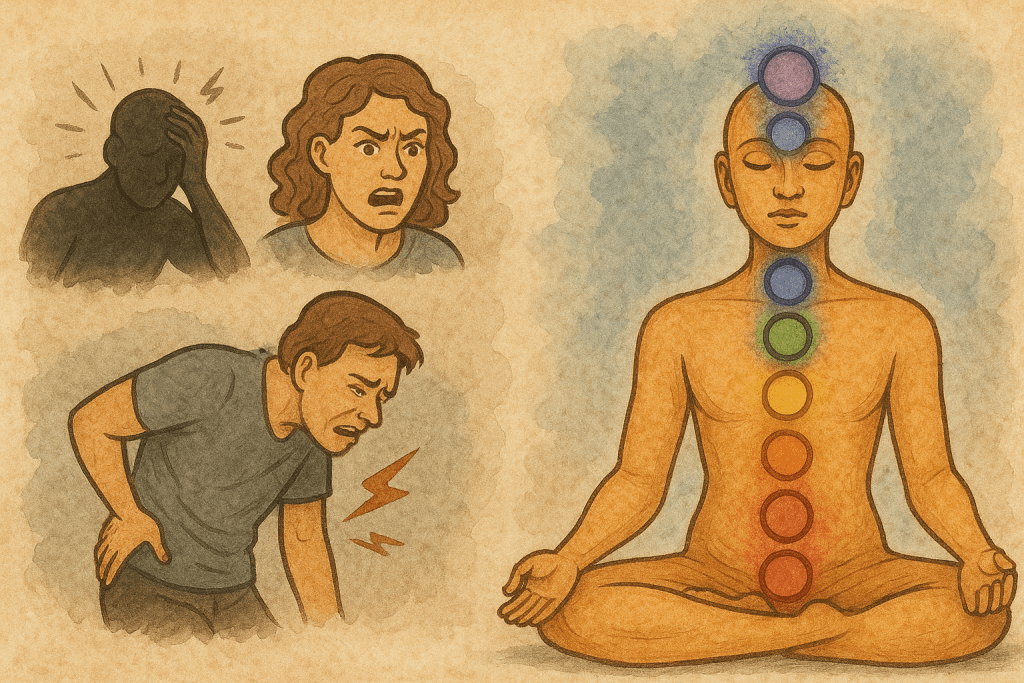
Are There Any Risks with Chakra Balancing?
Balancing your chakras might sound like the spiritual version of going to the gym tune up your energy, feel better, live your best life. But is it all sunshine and third-eye rainbows? Or could opening those energy centers bring some unexpected side effects?
Let us dive into the mystical (and sometimes misunderstood) world of chakra balancing and see what lies beneath the surface.
Understanding Chakra Balancing
What Are Chakras?
Chakras are believed to be energy centers in the body, originating from ancient Indian spiritual traditions. There are seven main chakras aligned from the base of the spine to the crown of the head, each linked to specific organs, emotions, and spiritual themes. Each chakra is associated with a specific chakra color and relates to particular physical, emotional, and spiritual functions, with some traditions noting possible connections to the endocrine and nervous system, though these links are not scientifically established.
Think of them as spinning wheels or circuits that keep your body and spirit in sync when they are in balance, things feel great. But when they are blocked or overactive, that is when trouble may begin.
What Is Chakra Balancing?
Chakra balancing is the practice of restoring harmony and flow across these energy centers. People use various tools for this from meditation and reiki to crystals, sound baths, essential oils, and even yoga. Many also use different methods to balance your chakras, achieve chakra alignment, and perform chakra cleansing to maintain optimal energy flow.
Common Techniques Used
- Reiki: Channeling healing energy through hands
- Crystal Healing: Using stones like amethyst or quartz aligned with chakra frequencies to harness their healing power
- Sound Therapy: Tuning forks, singing bowls, or mantras that utilize the healing power of sound frequencies to target energy centers
- Meditation and Visualization: Guided practices to open and align chakras
- Aromatherapy: Scents that stimulate specific chakras
These techniques work by influencing the energy channels that connect the chakras, supporting the balanced flow of energy throughout the body.
The Importance of Breathing Exercises
Breathing is more than just a basic function it’s the bridge between your physical body and your energetic self. In the world of chakra balancing, breathing exercises are like the secret ingredient that helps keep your seven main chakras root chakra, sacral chakra, solar plexus chakra, heart chakra, throat chakra, third eye chakra, and crown chakra functioning properly and in harmony.
When you focus on your breath, you’re not just calming your mind; you’re also encouraging energy flow through your body’s energy centers. Each inhale and exhale can help clear blockages, restore balance, and support the natural rhythm of your chakra system. For example, deep, mindful breathing can activate the solar plexus chakra, boosting your personal power and self esteem, while gentle, grounding breaths can stabilize the root chakra, helping you feel safe and connected to earth energy.
Breathing exercises are a cornerstone of chakra meditation and yoga poses, offering a simple yet powerful way to connect with your inner self. By tuning into your breath, you can cultivate emotional balance, reduce stress, and enhance spiritual awareness. This mindful approach not only supports your energetic body but also promotes physical health helping to lower anxiety, improve sleep, and strengthen your immune system.
The Promised Benefits of Chakra Balancing
When done right, chakra balancing can feel like a warm inner massage for your soul. By supporting energy flowing freely through the chakras, it enhances creative energy and strengthens spiritual functions.
Practitioners and believers report benefits across body, mind, and spirit.
Emotional Clarity
Blocked chakras can manifest as emotional fog or overreactions, but balancing can help you connect with your inner guidance. Balancing can promote calm, boost confidence, and help with emotional regulation.
Physical Well-being
Each chakra is connected to organs and body systems. Chakras are also believed to influence the etheric body, an energetic layer connected to physical health and the flow of life force energy. For instance, a balanced root chakra may support lower back health, while a healthy throat chakra can ease tension in the neck and shoulders.
Spiritual Connection
Balancing chakras is often part of a deeper spiritual journey, promoting self-awareness, presence, and a sense of unity with something greater.
Chakra balancing can help bridge the gap between the physical world and the spiritual realm, allowing universal energy to flow freely through the chakras and fostering a sense of pure consciousness.
The Flip Side – Can It Be Risky?
Yes, even energy work has its risks. And while many downplay the negative side effects, they do exist especially if chakra work is done recklessly or without proper guidance. For example, a blocked root chakra can lead to feelings of instability or insecurity.
Psychological Disruption
Opening certain chakras (especially the third eye or crown) without grounding can cause confusion, disorientation, or spiritual overwhelm. People may experience sudden emotional releases, anxiety spikes, or mood swings. While some seek spiritual liberation through chakra work, it is important to approach these practices with caution to avoid psychological distress.
False Sense of Healing
Some might replace traditional therapy or medical treatment with chakra work, believing energy alignment will fix everything. This can delay critical care and worsen conditions.
Physical Symptoms
It is not uncommon for people to experience fatigue, nausea, dizziness, or headaches after an intense chakra session especially if their body is not prepared for the shift.
Energetic Overstimulation
Some people report a “high” after chakra sessions that quickly turns into a crash. This is often a sign that the energy body was overstimulated like doing a high-intensity workout without stretching first.
Who Might Be More Vulnerable?
While chakra balancing is safe for many, certain groups should be extra cautious. Individuals involved in esoteric traditions may be more attuned to subtle energies and thus more vulnerable to the effects of chakra balancing.
People with Pre-existing Mental Health Issues
Chakra work can bring up buried emotions, trauma, or existential confusion. Without professional mental health support, this can be destabilizing.
Overly Sensitive or Empathic Individuals
Highly sensitive people might absorb too much energy during group sessions or feel overwhelmed by the vibrations.
Those Without Grounding Practices
If you are opening upper chakras (like the crown or third eye) without anchoring the lower ones, you may feel spacey, disconnected, or even panicked.
The Science Behind the Skepticism
Lack of Clinical Evidence
Mainstream science does not recognize chakras as real anatomical structures. While chakra work may feel good, there is little empirical research proving its effectiveness beyond anecdotal reports.
The Placebo Effect
Some benefits might simply be due to belief. But hey if you feel better, does it really matter why? Still, it is worth keeping your expectations grounded.
Energy vs. Biology
Chakra talk uses spiritual or energetic language, which can conflict with scientific or medical frameworks. That does not mean it is wrong just that it works on a different dimension that science has yet to measure.
How to Safely Practice Chakra Balancing
Choose Certified and Experienced Practitioners
Look for people with credentials, good reviews, and a balanced, humble approach. Avoid those who make wild promises or scare you into coming back.
Integrate Grounding and Protection Techniques
Always start with grounding practices breathwork, nature walks, body movement especially before working on the upper chakras.
Combine with Traditional Therapies
Chakra work should complement, not replace, therapy, medication, or medical treatment. Think of it as the holistic cherry on top, not the entire cake.
Listen to Your Body
If you feel “off,” tired, or overwhelmed after a session, do not ignore it. Rest, drink water, journal — and maybe hold off on the next session until you feel stabilized.
Conclusion
So, are there risks with chakra balancing? The short answer: yes but they are usually avoidable. Like any powerful tool, energy healing requires intention, knowledge, and care. When used mindfully, it can be deeply transformative. But when misused or taken too far, it can leave you more out of whack than when you started.
Approach chakra work like you would a spiritual workout: warm up, go slow, and do not forget to cool down. Your energy body will thank you.
FAQs
Yes, especially if you stir up unresolved emotions or skip grounding. Sometimes, anxiety can be related to an imbalance in a specific chakra, such as the root or solar plexus, each of which has unique symbolism, colors, and energetic functions. It is best to work with someone experienced and inform them of any existing conditions.




